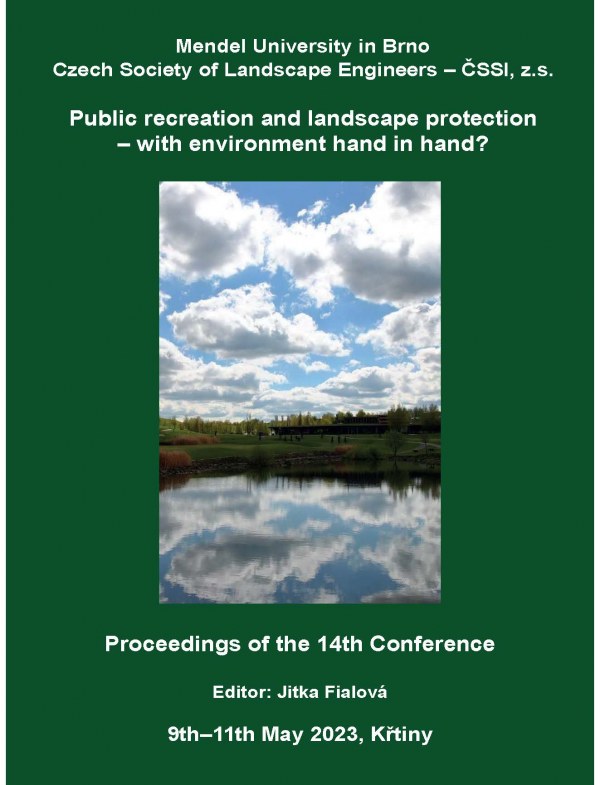
DOI: 10.11118/978-80-7509-904-4-0387
WINDBREAKS AS AN IMPORTANT ECO-STABILISING AND SOIL-PROTECTIVE ELEMENTS IN THE LANDSCAPE OF SOUTH MORAVIA
- Josef Kučera, Jana Podhrázská, Michal Pochop, Petr Karásek
South Moravia is one of the most popular and frequently visited areas for tourism and recreation. Cyclists can take advantage of the dense network of cycling paths of local, regional as well as European importance, which connect interesting localities in the area. Various landscape elements also contribute to the attractiveness of the landscape, among which vegetation linear elements have an irreplaceable function. Historically, windbreaks have been planted in the landscape of southern Moravia as protection against the adverse effects of wind. Their importance is growing, especially in view of the adverse effects of climate change. However, the health of many of the elements is often no longer satisfactory, which can cause serious problems. This is illustrated by the extreme weather event of 24 June 2021, when the area between Breclav and Hodonín was hit by a tornado, which caused enormous damage to the property and health of the inhabitants of the municipalities but also had significant destructive effects on the countryside. At the same time, a number of hiking and cycling routes pass through the area affected by the tornado. The present paper deals with the assessment of the condition of linear vegetation elements in the affected area. A total of 10 cadastral areas that were directly affected by the tornado were analysed. The analysis of the area will be useful for further proposals for the restoration or implementation of new windbreaks to mitigate the risk of wind erosion and other climatic extremes in this area, to increase the permeability and attractiveness of the landscape, and to support the construction of a new network of field roads, bicycle paths, and walk trails.
Keywords: climatic change; erosion; cycling; tourism; linear vegetation
pages: 387-391, Published: 2023, online: 2023
References
- Borrelli, P., et al. (2016). Towards a pan-European assessment of land susceptibility to wind erosion. Land Degradation & Development, 27(4): 1093-1105, DOI: 10.1002/ldr.2318.
 Go to original source...
Go to original source... - Cleugh, H. A. 1998. Effects of windbreaks on airflow, microclimates and crop yields. Agroforestry Systems, 41, 55-84.
 Go to original source...
Go to original source... - Doležal, P. et al. (2017). Řízení rizika větrné eroze. Certifikovaná metodika. Brno: VÚMOP,v.v.i.. Certifikační organ: SPU, číslo osvědčení:2/2017 SPU/O.
- Holý, M. (1994). Erosion and the Environment, Publishing house of the Czech Technical University, Prague. [in Czech].
- Falloon, P., Betts, R. (2010). Climate impacts on European agriculture and water management in the context of adaptation and mitigation-the importance of an integrated approach. Science of the total environment, 408(23), 5667-5687.
 Go to original source...
Go to original source... - Fryrear, D. W. et al. (2000). Revised wind erosion equation. Ann. Arid. Zone, 40, 265-279.
- Podhrázská J., et al., (2008). Optimization of Windbreak Functions in Agricultural Landscape. Research Institute for Soil and Water Conservation, v.v.i.: Brno. Ref. No. 17161/08-13070. [in Czech].
- Podhrázská J., et al., (2021). Zakládání a údržba větrolamů ve zhoršených pedoklimatických podmínkách. Certifikovaná metodika. Brno: VÚMOP, v.v.i.. Certifikační orgán: SPU, Číslo osvědčení:1/2022SPU/O
- Střeštík J., et al. (2014). Increase of annual and seasonal air temperatures in the Czech Republic during 1961-2010. In: Rožnovský, J., Litschmann, T. (Eds.). Mendel and Bioclimatology. Conference proceedings, Brno, 3rd-5rd Sep. 2014 [CD]. Brno. ISBN 978-80-210-6983-1.


